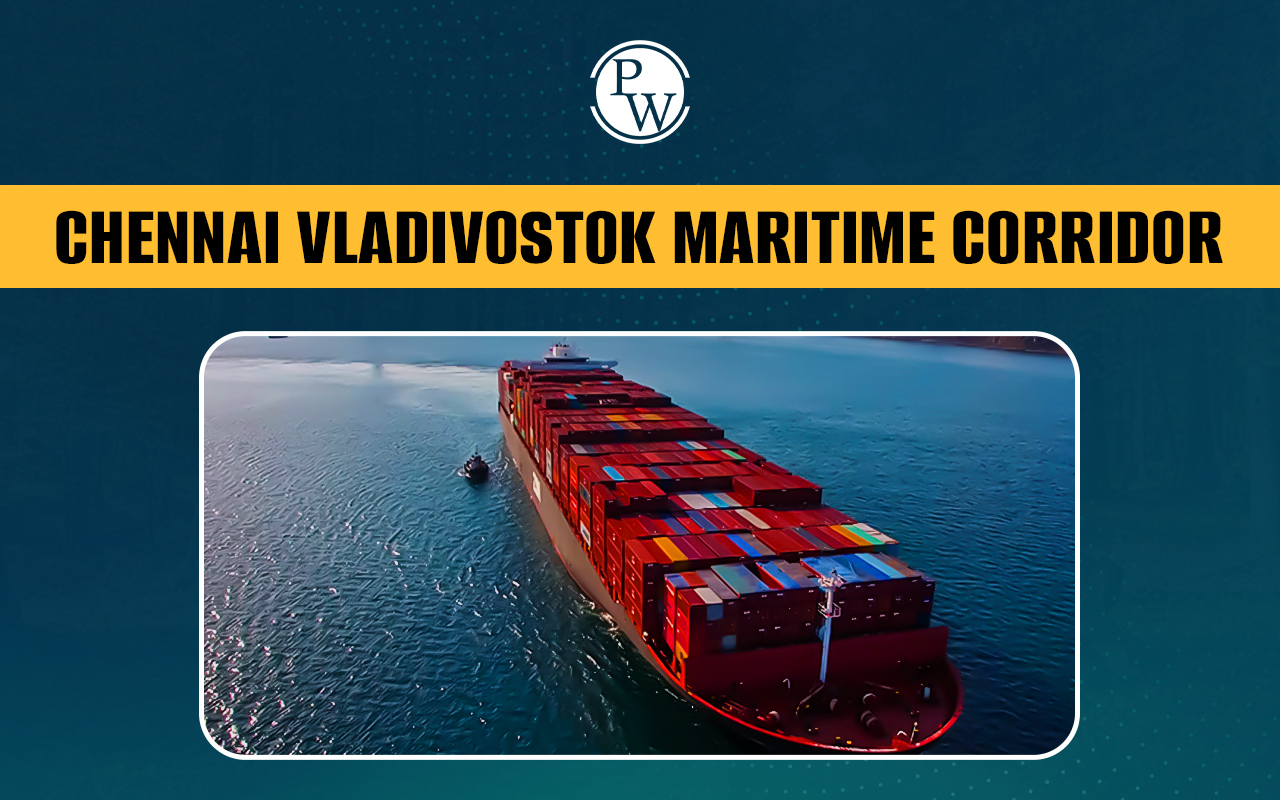

The launch of the Chennai Vladivostok Maritime Corridor (CVMC) marks a significant milestone in the bilateral relationship between India and Russia. This strategic sea route, officially announced as operational by the Union Minister of Ports, Shipping and Waterways in November 2024, is poised to redefine maritime trade and energy cooperation between the two nations.
The Chennai Vladivostok Maritime Corridor is a direct maritime link designed to overcome traditional logistical challenges and boost the Special and Privileged Strategic Partnership shared by India and Russia.
What is the Chennai Vladivostok Maritime Corridor (CVMC)?
Chennai Vladivostok Maritime Corridor is an approximately 5,600 nautical mile (10,300 km) sea route that directly connects the port of Chennai on India's east coast with Vladivostok, the largest port in Russia's Far East. Also known as the Eastern Maritime Corridor (EMC), this initiative was conceptualised in September 2019 following a Memorandum of Intent signed by Indian Prime Minister Narendra Modi and Russian President Vladimir Putin in Vladivostok.
The primary goal of the corridor is to enhance trade, investment, and connectivity by creating a more efficient, direct, and time-saving sea route. The corridor complements other major connectivity projects like the International North-South Transport Corridor (INSTC) and is integral to India's vision for a robust, diversified maritime network.
Features and Route of the Eastern Maritime Corridor
The Chennai Vladivostok Maritime Corridor offers compelling advantages over traditional routes, primarily by drastically reducing both distance and transit time.
Route and Ports
-
Anchor Ports: The route links Chennai Port in India with Vladivostok Port in Russia.
-
Route Path: The corridor passes through the Bay of Bengal, the Strait of Malacca, the South China Sea, and the Sea of Japan.
-
Indian Ports: While anchored at Chennai, the corridor has the potential to connect other major Indian ports on the east coast, including Visakhapatnam (Vizag) and Paradip.
-
Intermediate Stops: Russia has proposed including Southeast Asian nations like Vietnam, Thailand, and Indonesia as intermediate stops, enhancing regional connectivity and trade with ASEAN countries.
Distance and Time Savings
The traditional maritime route between India's western ports (like Mumbai) and Russia's European ports (like St. Petersburg) traverses the Suez Canal, covering approximately 8,675 nautical miles and taking around 35 to 40 days.
In contrast, the CVMC reduces the shipping distance to about 5,600 nautical miles. This shorter path is expected to cut the cargo transit time to merely 24 days, representing a reduction of up to 16 days or approximately 40%.
Economic and Trade Significance for India and Russia
The operationalisation of the Chennai Vladivostok Maritime Corridor is critical for achieving the ambitious bilateral trade targets set by India and Russia, which aim for $100 billion by 2030.
Reducing Logistics Costs and Boosting Efficiency
The single most important economic advantage is the significant reduction in time and distance, which directly translates to lower logistics costs, greater trade efficiency, and reduced fuel consumption. This cost-effectiveness is crucial for making Indo-Russian trade more competitive on the global stage.
Diversification of Trade and Access to Resources
The corridor facilitates the trade of high-volume commodities, opening up new markets and resource access:
-
Russia's Exports to India: The Far East region of Russia is rich in natural resources. The CVMC is a vital channel for importing key commodities into India, primarily crude oil, liquefied natural gas (LNG), coal, fertilisers, and metals. Given India's increasing role as the largest buyer of Russian oil, this corridor is key to India's energy security.
-
India's Exports to Russia: India can export pharmaceuticals, machinery, agricultural products, textiles, and manufactured goods to Russia’s Far East, supporting India's 'Make in India' initiative.
Strategic and Geopolitical Importance of CVMC
Beyond economics, the Chennai Vladivostok Maritime Corridor holds profound strategic and geopolitical implications for both countries, especially in the evolving Indo-Pacific security landscape.
Strengthening India's Act Far East Policy
The CVMC is a tangible manifestation of India's "Act Far East Policy," which aims to deepen engagement, investment, and strategic presence in the resource-rich Russian Far East (RFE). By enhancing connectivity, India gains better access to the RFE’s strategic commodities and promotes joint ventures in sectors like mining, energy, and logistics.
Diversifying Strategic Sea Lanes
The corridor provides a critical alternative to traditional, longer routes that pass through congested maritime chokepoints like the Suez Canal. By diversifying its trade routes, India reduces its vulnerability to geopolitical instability and potential disruptions in the West Asian regions.
Connecting to the Northern Sea Route (NSR)
The CVMC is strategically linked to Russia's Northern Sea Route (NSR), an Arctic shipping lane that drastically shortens the distance between East Asia and Europe. Through the CVMC, India gains a direct maritime access point that can connect it to the NSR, fostering joint development in Arctic shipping and polar navigation.
This cooperation involves joint efforts to construct ice-class vessels at Indian shipyards and train Indian seafarers for Arctic voyages, establishing India as a significant partner in the Arctic maritime domain.
Operational Status and Future of the Chennai-Vladivostok Link
The Chennai Vladivostok Maritime Corridor has been declared operational. Container ships have already begun utilizing the route, carrying commodities such as crude oil, food, and machines to Indian ports.
Future efforts are focused on improving the corridor's viability through infrastructural development and deeper bilateral cooperation:
-
Port Infrastructure: Focus will be on developing port infrastructure and facilities in both regions to handle increased traffic.
-
Shipping and Logistics: India and Russia are working together on shipbuilding and ship-repair clusters, particularly for specialised ice-class tankers necessary for operating in the Arctic parts of the extended route.
-
Alignment with INSTC: The CVMC is being developed in conjunction with the INSTC to create a comprehensive multi-modal connectivity network spanning Eurasia and the Indo-Pacific.
The Chennai Vladivostok Maritime Corridor is not just a commercial shipping lane; it is a strategic asset that will cement the long-standing special relationship between India and Russia, open new economic frontiers, and significantly contribute to India's goals under the Sagarmala Programme.
Chennai Vladivostok Maritime Corridor FAQs
What is the approximate length of the Chennai Vladivostok Maritime Corridor (CVMC)?
How much time does the Chennai Vladivostok Maritime Corridor save for cargo transport?
Which major ports does the Chennai Vladivostok Maritime Corridor connect?
What is the strategic significance of the Chennai Vladivostok Maritime Corridor for India?
When did the Chennai Vladivostok Maritime Corridor become operational?








